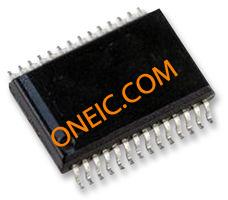PIC16F1938-I/SS
8-bit microcontrollers with flash memory for versatile electronic applications
Manufacturer: microchip
series introduction
# Introduction to the PIC16F1938 - I/SS Product Series
## 1. Overview
The PIC16F1938 - I/SS is part of Microchip Technology's PIC16F microcontroller family. These microcontrollers are renowned for their high - performance, low - power consumption, and rich set of integrated peripherals, making them suitable for a wide range of embedded applications. The "I/SS" in the part number typically refers to a specific package type and temperature range, often indicating a small - scale, surface - mount package that is ideal for space - constrained designs.
## 2. Key Features
### 2.1 CPU and Memory
- **CPU Core**: The PIC16F1938 is based on an enhanced mid - range RISC CPU architecture. It offers a high - speed instruction execution, with most instructions being executed in a single cycle. This allows for efficient code execution and fast response times in real - time applications.
- **Program Memory**: It comes with a certain amount of Flash program memory. This non - volatile memory is used to store the user's application code. The Flash memory is reprogrammable, enabling developers to easily update and refine their software during the development process or for field upgrades.
- **Data Memory**: The microcontroller has a dedicated data memory, including RAM (Random Access Memory). The RAM is used for storing variables, intermediate results, and other data that needs to be accessed quickly during program execution.
### 2.2 Peripherals
#### 2.2.1 Timers
- **Multiple Timer Modules**: The PIC16F1938 is equipped with several timer modules, such as Timer0, Timer1, and Timer2. These timers can be used for a variety of purposes, including generating time delays, measuring time intervals, and generating PWM (Pulse Width Modulation) signals.
- **PWM Generation**: The timer modules can be configured to generate PWM signals, which are widely used in applications such as motor control, LED dimming, and power management. The PWM signals can be adjusted in terms of frequency and duty cycle, providing flexibility for different application requirements.
#### 2.2.2 Communication Interfaces
- **USART (Universal Synchronous/Asynchronous Receiver/Transmitter)**: This interface allows the microcontroller to communicate with other devices using serial communication protocols. It supports both synchronous and asynchronous communication modes, making it compatible with a wide range of serial devices, such as sensors, displays, and other microcontrollers.
- **SPI (Serial Peripheral Interface)**: The SPI interface provides a high - speed, synchronous serial communication method. It is commonly used for communicating with external devices such as EEPROMs, ADCs (Analog - to - Digital Converters), and DACs (Digital - to - Analog Converters).
- **I²C (Inter - Integrated Circuit)**: The I²C interface is a multi - master, multi - slave serial communication protocol. It is widely used for connecting low - speed devices, such as sensors, real - time clocks, and other integrated circuits, in a compact and efficient manner.
#### 2.2.3 Analog - to - Digital Converter (ADC)
- **On - chip ADC**: The PIC16F1938 features an on - chip ADC with multiple input channels. This allows the microcontroller to convert analog signals from sensors, such as temperature sensors, light sensors, and pressure sensors, into digital values that can be processed by the CPU. The ADC has a certain resolution (e.g., 10 - bit or 12 - bit), which determines the accuracy of the analog - to - digital conversion.
### 2.3 Low - Power Operation
- **Multiple Power Modes**: The microcontroller supports multiple
Images for reference

28-SSOP, M28

28-SOIC

Image Preview